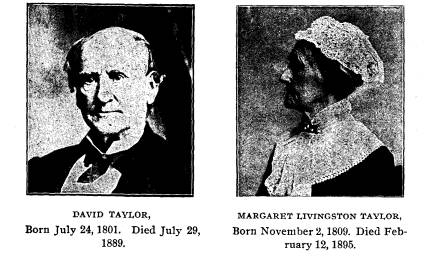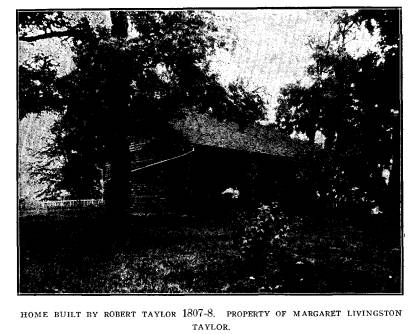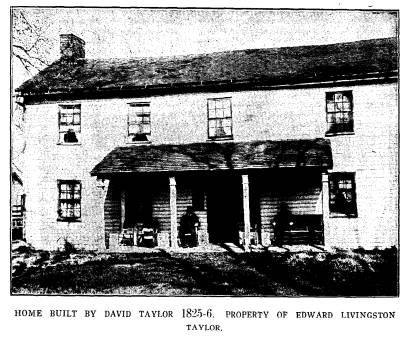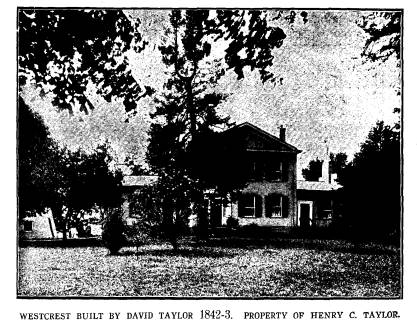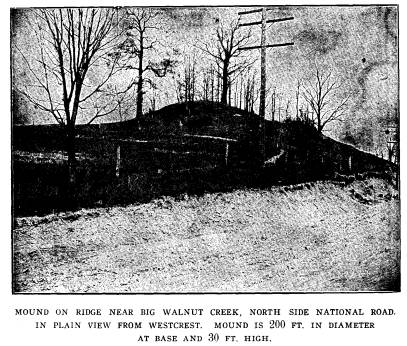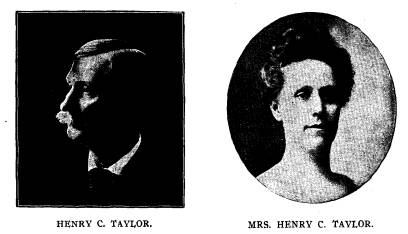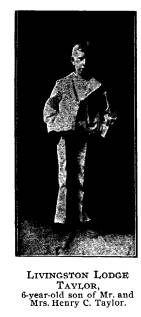Ohio History Journal
THE TAYLOR-LIVINGSTON CENTENARY
IN FRANK-
LIN COUNTY.
On the 9th day of
June, 1904, a reception was given by Mr.
and Mrs. Henry C.
Taylor, at their country place, Westcrest,
situated on the
National Road, west bank of Big Walnut creek
in Truro township, to
commemorate the one hundredth anni-
versary of the family
history in Franklin County. The invitation
issued to the guests
on this occasion was in the following form:
1804 TAYLOR-LIVINGSTON 1904
MR. AND MRS. HENRY C.
TAYLOR,
REQUEST THE HONOR OF
YOUR PRESENCE
AT WESTCREST
THURSDAY, JUNE THE
NINTH
AT TWO O'CLOCK
TO COMMEMORATE THE
ONE HUNDREDTH ANNIVERSARY
OF THE FAMILY
SETTLEMENT
IN FRANKLIN COUNTY.
The number present in
response to these invitations was
between seven and
eight hundred.
The hostesses and
assistant hostesses were:
Hostesses.
MISS MARGARET L.
TAYLOR, MRS.
SAMUEL LEE,
MRS. THOMAS HIBBEN, MRS.
JOHN M.
TAYLOR,
MRS. THEODORE
HUNTINGTON, MRS. EDWARD L. TAYLOR, JR.,
MRS. HENRY N. TAYLOR, MISS
KATHARINE M. TAYLOR,
MRS. JOHN H. J. UPHAM, MISS MARGARET T. SHARP,
MRS. CHAPIN C.
FOSTER.
(486)
The
Taylor-Livingston Centenary, Etc. 487
Assistant
Hostesses.
MRS. ANDREW D.
RODGERS, MRS.
WILLIAM HOPKINS,
MRS. ROBERT S. SMITH, MRS. WILLIAM K. ROGERS,
MRS. JOHN JOYCE, MRS.
FRANCIS COLLINS,
MRS. JOSEPH H. POTTER, MRS.
ALFRED KELLEY,
MRS. JAMES KILBOURNE, MRS.
ROBERT S. NEIL,
MRS. ALLEN W. THURMAN, MRS. WILLIAM
J. McCOMB,
MRS. RUTHERFORD H.
PLATT, MRS. RANDOLPH S. WARNER,
MRS. CHARLES F. CLARK, MRS.
WALTER W. BROWN,
MRS. WILLIAM BLACK, MRS.
EDWARD DENMEAD,
MISS SULLIVANT, MISS
JANE SULLIVANT,
MISS REBEKAH
SULLIVANT, MRS.
RICHARD T. CLARKE,
MRS. WILLIAM BURT.
The hostesses
consisted of members of the family; the
assistant hostesses
were representative of the families that came
to Franklinton and
Columbus at a very early period, some of
them in the closing
decade of the 18th century.
It was unique in being
the first entertainment of this kind
ever given in Franklin
County, and this fact alone was sufficient
to make the day
memorable. An interesting feature was the
large attendance of
those who were advanced in years. It was
the purpose of Mr.
Taylor, who conceived the idea of having a
celebration of this
character, to bring together as many as pos-
sible of the pioneers
and their descendants, and in this respect
he was eminently
successful. There were present three persons
over ninety years of
age, and perhaps fifteen or more ranging
from seventy-five to
ninety. In this list were a twin brother
and sister in their
eightieth year. The one having the longest
span of life was Mrs.
William Sprague, who was born on the
3rd day of September,
1808, and was consequently almost ninety-
six years of age. The
next in order was Mr. Elam Drake,
in his ninety-second
year, his birthday being November 16, 1812;
and the third was Mrs.
James Staley, whose ninety-second birth-
day will occur-a kind
Providence permitting-on the 22nd
day of December, 1904.
It was a noteworthy fact that Mr.
Drake was one of the
persons employed in the building of
the house at Westcrest
in 1843, a period of sixty-one years
488 Ohio Arch. and Hist.
Society Publications.
having elapsed since he performed this
labor. He is quite well,
is possessed with a cheerful disposition
and has fair promise of
living out a century. Mrs. Sprague was
in excellent health and
strength, took part in the exercises of
the afternoon, reciting a
poem of her own composition on the
appropriate subject of
"Growing Old." The recitation
was given with full strong
voice and good emphasis. On account of
her great age, it will
doubtless be interesting to many persons
to read the verses
recited by Mrs. Sprague, and a copy is
here given.
I'm growing old, that's what they say;
I know my hair has turned to gray,
And step is not as brisk and fine
As when I was just twenty-nine.
The wrinkles on my face show clear
They've been there now for many a year;
Without a doubt they've come to stay,
For man was made of dust, they say.
I'm growing old. I know it's so -
This is the way we all do go.
I will move out this house of dust
To mansions that's prepared for us.
No earthy goods I'll take with me,
I will not need them there, you see.
The city that is paved with gold,
Hath glories that cannot be told.
Our great High Priest, He will be there-
He, when on earth, our pains did share.
And glorious anthems we will sing,
For there will be our heavenly King.
In addition to the social meetings and
greetings of the
great number of guests present, which
continued for several
hours upon the large and beautiful lawn
at Westcrest, there were
formal exercises, presided over by Mr.
Rutherford Hayes Platt.
They consisted of prayer by the
venerable Rev. Edward D. Mor-
ris, D.D., the oldest Presbyterian
minister in Columbus; an ad-
dress of welcome by Mr. Henry C. Taylor;
introductory address
by Mr. Rutherford H. Platt; the reading
by Edward L. Taylor,
|
The Taylor-Livingston Centenary, Etc. 489 Jr., of a paper prepared by his father, Edward L. Taylor, Sr.; address by ex-Governor George K. Nash; address by Col. James Kilbourne; address by Hon. Phil. H. Bruck; recitation of poem by Mrs. William Sprague; address by Hon. Thomas E. Powell. The program as carried out was from first to last impres- sive, instructive and entertaining, characterized by sentiment, wit and humor. Immediately upon the conclusion of the exer- cises supper was served and the closing hours of the beautiful afternoon in June was spent in social intercourse by hundreds of the descendants of the pioneer settlers in Franklin County. |
|
|
|
ADDRESS OF WELCOME.
BY HENRY C. TAYLOR. Ladies and Gentlemen - It gives me great pleasure to have so many acquaintances and friends here to-day. I thank you for the compliment of your presence on this historic occasion. On behalf of all the members of my family I extend to you all the most cordial welcome, and I trust that you may experi- ence as much pleasure in being guests as we do in being hosts. I should like to indulge the hope, that one hundred years hence, your denscendants and mine might under like favorable |
|
490 Ohio Arch. and Hist. Society Publications.
circumstances assemble at this place to commemorate the com- pletion of the second century, as we have the first. In the closing years of the 18th and the opening years of the 19th century, a tide of emigration began to move from the Atlantic coast states, west over the Alleghanies and into that territory, that was designated as northwest of the river Ohio. These emigrants came on foot, on horseback, in wagons, along the wilderness roads and Indian trails, and in boats upon |
|
|
|
the navigable streams. Their object was to establish themselves in new homes in a new country; to win from the forests and plains a competence for themselves and their families. They were adventurers only in the highest and best sense of that word. They were not gold seekers, in search of hidden treasures, but were home-seekers and founders of new commonwealths. With courage, with faith, with hope they left their old associations, their kindred, their friends, and went forth to meet hardships |
The Taylor-Livingston Centenary,
Etc. 491
and privations in what was to them at
that time a far-off coun-
try. They were a race of men and women
whom any nation
would be happy to have as citizens.
The Puritan of New England, the Cavalier
of the south,
the Dutch, the English, the Irish, the
Scotch, never to be sur-
passed by any of the races of the
children of men. History is
more and more abundantly honoring their
noble qualities and
great deeds. They triumphed in the east,
in securing our in-
dependence; they won the west; they
traversed the continent,
and saved it all for the nation founded
by Washington and his
compatriots. We shall never weary in
recounting their great
virtues, their heroic qualities, their
lives of noble endeavor and
of sacrifice. They were firm in their
conviction, self-reliant in
their character, and possessed of a fine
dignity in their lives.
The Bible and the Declaration of
Independence were their
religious and civil guides. The church and the schoolhouse
were the two institutions first provided
for and most highly
prized. These nurseries of piety and
learning were remote and
of difficult access, as must necessarily
be the case, in a sparse
and widely scattered population. We can
now scarcely conceive
the difficulties encountered by the men
and women who came
here with the first wave of emigration.
They labored and we
enjoy the fruits of their labor. We reap
the benefit of their
toil and self-denial. To-day the
sunshine and shadow may come
and go upon the ground where we are
assembled. Three gen-
erations ago, it was covered with such
heavy forest, that the
sun could rarely kiss the earth.
To clear away the trees and make room
for a home in the
virgin forest was indeed a labor. There
are those living to-
day, who can remember the dark border of
forest trees that lined
the narrow strip of road leading from
their homes to the then
small city of Columbus. And in later
years upon their return
home in the evening, the way may have
been lighted up by
the burning logs in the clearings. The
heavy fringe of great
trees has long since disappeared under
the heavy blows of the
woodman's ax, the clearing fires have
gone out, and the logs
were many years ago covered with their
ashes.
492 Ohio Arch. and Hist. Society Publications.
From the ruins of this first estate, we
have the smiling land-
scape, the green grass, the fertile
fields of waving grain. We
have the advantages, ease, comfort,
conveniences, luxuries of
modern civilization. For the generation
that first came to this
goodly land, and rough-hewed the way
there is lasting remem-
brance and perpetual honor. In their
lives there was a serious-
ness of purpose that is not
characteristic of the later generation.
In the midst of difficulties and dangers
there was exhibited to
an unusual degree the qualities of
fortitude and endurance.
The Indian trails and wilderness roads
have disappeared.
The horseback riders from New York,
Pennsylvania, Connecti-
cut no longer pass along the old highway
bordering these
grounds. The stage coach, the wonder and
admiration of seventy
years ago, has ceased to pitch and creak
and roll its heavy way
eastward and westward. The moving
wagons, that so frequently
lined this road when Ohio was a new
state and Indiana and
Illinois almost unknown territory, have
passed into a faint tra-
dition. To-day the merchants in
Franklinton do not ship their
goods over the Alleghany Mountains in a
Conestoga wagon.
There are those here to-day in the fifth
generation from
the first settler. They can daily
witness many marvelous things
unknown to their forefathers in this
country, and beyond the
realm of their conception or dreams.
There has been material progress and a
marked change
in social life. We do not look back with
regret to the good
old times, rather we rejoice in the good
new times, and look
forward to an ever changing, and ever
better condition of
human existence. But when we come to
estimate the sterling
qualities that make a man or woman, we
shall probably never
find them in a finer combination, or a
higher degree of develop-
ment, than in the pioneers who located a
century ago in Franklin
County.
ADDRESS BY EDWARD L. TAYLOR, SR.
[Edward Livingston Taylor, Sr., was not
able to be present on
account of illness. The address was read
by his son Edward Livingston
Taylor, Jr., Prosecuting Attorney for
Franklin County.]
The Livingston and Taylor families
represented here to-day both
had their origin in Scotland. Their
ancestors had lived there for many
|
The Taylor-Livingston Centenary, Etc. 493
generations. Branches of these families left Scotland for the same reason (religion), the Livingstons going to Holland and the Taylors to the north of Ireland; and it so happened that through widely different channels and experiences the branches of these families, which settled in Franklin County, Ohio, came and located here about the same time, now a hundred years ago. The common ancestor of the Livingston family in this country was the Rev. John Livingston, who was born in Scotland in 1603, and whose death occurred at Rotterdam, Holland, in 1672. He was a min- |
|
|
|
ister in the Scotish church, as had been his father, William Livingston, and grandfather, Alexander Livingston, before him. In 1662 there was passed in England what is konwn as the "New Act of Uniformity," by which the penal laws against dissenters and non-conformists were revived. By this act every minister in England, Scotland and Wales, who received any benefit or support from the government was required to declare his assent to all and everything contained in the "Book of Common Prayer," and no one could hold preferment without Episcopal ordination. The Rev. John Livingston refused to conform to this act and so, in order to escape its penalties. |
494 Ohio Arch. and Hist. Society Publications.
was compelled to take refuge in Holland,
where he spent the last nine
years of his life.
The Rev. John Livingston had two sons,
Robert and William.
They were born in Scotland but went with
their father to Holland
where they received much of their
education, a part of which was the
learning of the Dutch language which had
an important influence upon
their after life.
Robert was born in 1654 and soon after
arriving at lawful age came
to America and settled at Albany, N. Y.,
where there was a colony
or settlement of Hollanders. His
acquaintance with the Dutch language
and his preference for the Hollanders
determined in no small degree his
location at that place.
In 1683 he was intermarried at Albany,
N. Y., with Alida, widow
of Rev. Nicholas Van Rennselaer, whose
maiden name was Schuyler,
and through this marriage Robert became
the first founder of the Liv-
ingston family in America.
In 1696 he re-visited Scotland and on
his return brought with him
a nephew, Robert, Jr., a son of his
brother William. He too settled
at Albany, and the uncle and nephew were
thereafter known and desig-
nated as Robert, Sr., and Robert, Jr. In
1697 Robert, Jr., was inter-
married at Albany with Margaretta
Schuyler, who was a niece of the
wife of Robert, Sr.; so that they were
respectively nephew and niece
of Robert, Sr., and his wife,
Alida. From this marriage sprang the
branch of the Livingston family represented
here to-day. Of this mar-
riage there was born in 1709, a son,
John Livingston, who, on Septem-
ber 6th, 1739, was married to Catryna
Ten Broeck. Of that marriage
there was born three sons, James,
Richard and Abraham, all of whom
located in Montreal, Canada, before the
breaking out of the Revolu-
tionary War. They were all active and
determined sympathizers with
the cause of the colonies and so
incurred the displeasure of all sympa-
thizers with and adherents of the cause
of Great Britain.
Col. James Livingston, the oldest of
these three brothers and from
whom the Livingstons represented here
to-day are directly descended,
was born March 27th, 1747, and died
November 29th, 1832.
In 1772, at Montreal, Canada, where he
was then practicing his
profession as a lawyer, he was married
to Elizabeth Simpson, who had
been born at Cork, Ireland, October,
1750, and who died June 20th,
1799. Several children were born of this
marriage, but we are to-day
only concerned with Edward Chinn
Livingston, who was the third son
and fifth child of that marriage, born
in the State of New York, May 23d,
1782. and removed to Franklin County,
Ohio, in 1804.
In the year 1775, the public mind
throughout the American colonies
and the British provinces had become
greatly disturbed and agitated
on account of the bitter controversies
between a majority of the people
of the colonies and Great Britain. A
large majority of those then
The Taylor-Livingston Centenary,
Etc. 495
living in what is now the British
Provinces of Canada and Nova Scotia
were strong adherents of the cause of
Great Britain. They called them-
selves "Loyalists," but were
generally known and designated at "Tories."
There was also in Canada a minority who
were strongly in favor of
the cause of the colonies as against the
cause of the king. The result
was that many Tories fled from the
colonies to Canada and induced
the Mohawk Indians and many of the
Indians belonging to other tribes of
the Iroquois then living in the state of
New York, to join them in
hostilities against the patriots or
colonists. These refugees to Canada
and their Indian allies remained in
active hostilities to the people of
the colonies throughout the war of the
Revolution, during which time
they caused great devastation and
destruction of life and property in
almost every part of the State of New
York, but particularly through-
out the Mohawk Valley. The operations of
these refugees to Canada
and their Indian allies, constitutes the
most dreadful chapter in the
history of that war.
On the other hand, those who lived in
Canada and sympathized with
the cause of the colonies fled from that
country and actively and de-
terminedly espoused the cause of the
colnoies against the mother coun-
try. Those who fled from Canada were
called "Refugees from Canada;"
and those who fled from the colonies to
Canada were called "Refugees
to Canada." Of the refugees from
Canada, the three Livingston brothers,
before mentioned, were among the most
conspicuous and active in their
efforts in favor of the colonies. They
got together in Canada about
three hundred sympathizers and succeeded
in the face of great diffi-
culties and dangers in bringing them
safely over the border into the
State of New York, where they were
merged into a New York regi-
ment, of which James Livingston became
the colonel, Richard the lieu-
tenant colonel, and Abraham a captain.
This regiment was immedi-
ately assigned to the command then
organizing under General Schuyler
and General Richard Montgomery for the
invasion of Canada, with the
view of wresting that country from
British dominion. General Schuy-
ler's health failing, the command of the
expedition devolved upon Gen-
eral Richard Montgomery, whose wife was
a near relative of the three
Livingston brothers before mentioned, he
having married into the Liv-
ingston family.
General Montgomery very successfully
commanded the expedition
and took possession of all the country
along the St. Lawrence as far
as Quebec, which stronghold he assaulted
on the last night of Decem-
ber, 1775, where he met his death. The
command of the invading army
then fell upon Benedict Arnold, who was
second in command and who
was then a very active and capable
officer of the Colonial army. He
succeeded in withdrawing the American
army from Canada, but not with
out great difficulties, hardships and
sufferings.
|
496 Ohio Arch. and Hist. Society Publications.
Col. James Livingston served as colonel of his regiment during the entire seven years war. The British authorities confiscated his property and estate and declared him to be a rebel and an outlaw and set a heavy price upon his head. He, however, was fortunate enough never to fall into the hands of the Tories and their allies-the Mohawk and other Indians of the Iroquois tribe. After the war was closed he remained with his family in the state of New York and served for eight years in the Legislature of that state and held other positions of trust and honor. He died in 1832 at the advanced age of eighty-six years. |
|
|
|
In 1801 the Congress of the United States passed an act intended in part to remunerate the "Refugees from Canada" whose property had been confiscated or destroyed on account of their loyalty to the Ameri- can cause. Under the provisions of that act there was set off to Col. James Livingston land to the amount of 1,280 acres to be located on the "Refugee Tract," on a part of Which the city of Columbus now stands. The patents for a part of these lands were turned over to his son, Edward Chinn Livingston, who was then a young man just out of college and who soon thereafter (1804) came to Ohio and took pos- session of the lands given him by his father. All the lands granted |
The Taylor-Livingston Centenary,
Etc. 497
to Col. James Livingston were in what is
known in law and history as the
"Refugee Tract." They were all
located along Alum creek, just east of
the city of Columbus.
The "Refugee Tract," as set
apart by the government for the special
purpose before mentioned, was a strip of
land four and a half miles
wide from north to south and about fifty
miles from east to west,
extending from the east bank of the
Scioto river to near the Muskingum
river. The city of Columbus is situated
on the west end of this tract
and what is now Fifth Avenue was the
north line of the tract, and what
is now Steelton was the south boundary.
The whole contained about
136,000 acres. All that part of the
Refugee Tract which lies in Franklin
County was embraced in Montgomery and
Truro townships. To Ed-
ward Chinn Livingston was given the
honor of naming Montgomery
township, after General Richard
Montgomery, with whom his father
had been associated in the Revolutionary
war, and who was with him
at the time he fell at Quebec. A similar
honor was granted to Robert
Taylor, in giving him the privilege of
naming Truro township after
the town of Truro in the Province of
Nova Scotia, from whence
he came.
There was at the time of his coming to
this country no sign of
the city of Columbus beyond a few log
cabins a half mile west of the
Scioto river on what is now called West
Broad street, and at that
time called Franklinton. Letters in my possession, written before the
location of Columbus was settled, show
that Judge Edward C. Livingston
was very anxious to have the state
capital established on the east side of
the Scioto River and that he used every
influence possible to bring about
that result.
When Judge Livingston came to the county
the Nelson family, the
White family and the Moobery family were
the only residents along
Alum
creek in that neighborhood. The
Nelson family, the White
family and the Livingston family still
own and occupy portions of these
lands after the passing of a hundred
years. The Moobery family have
no representatives now living in the
country, in so far as we are aware.
On March 17th, 1807, Edward Chinn
Livingston was married to
Martha Nelson. There were born of that marriage children as fol-
lows: James, Margaret, Edward, Caroline,
Adaline, Angelica, Robert
and Martha. James was the oldest son,
who, when he was yet a young
man, located in Livingston county, in
north Missouri, where he died about
the year 1850. Margaret (my mother), the
oldest daughter, was born
November 2, 1809, and was married to my
father, David Taylor May 16th,
1836, and died February 12th, 1895.
Edward, the second son lived until
his death some thirty years ago, on a
part of his father's land, which
some of his children still own and
occupy. Caroline and Angelica died
childless more than thirty years ago.
Adaline (Mrs. Elijah Marion),
Vol. XIII -32.
498 Ohio
Arch. and Hist. Society Publications.
Robert and Martha are still living.
Robert owns and occupies the lands
where he was born almost eighty years
ago.
Under the date of December 14th, 1810,
Edward C. Livingston
was appointed colonel of the 2nd
Regiment, 4th Brigade and 2nd Di-
vision of Militia of Ohio, by Return
Jonathan Meigs, governor.
During the war of 1812 he assembled the
regiment to be in readi-
ness for service in the war then in
progress against Tecumseh and his
Indians and Proctor and his British
soldiers, but the regiment was not
called on for active service. He also
served as one of the associate
judges for Franklin county from 1821 to 1829. His death occurred
November 13, 1843.
TAYLOR FAMILY.
The Taylor family, as stated before, had
its origin in Argyle, Scot-
land, from whence they removed to the
north of Ireland in 1620. They
remained in and about the city of
Londonderry until 1720, when Matthew
Taylor, the progenitor of this branch of
the Taylor family in America,
came in a colony from Londonderry,
Ireland, to New Hampshire. The
colony was composed entirely of what is
known as Scotch-Irish people.
The governor of Massachusetts alloted to
them lands on which this
colony settled and which they began to
improve when it was found that
the land was in fact over the line in
New Hampshire. The governor
of New Hampshire, however, confirmed the
grant and the colony re-
mained in that location. They gave to
the settlement the name of Lon-
donderry, which has since been changed
to and is now known as Derry,
New Hampshire. This location was then
the very frontier of civili-
zation. All beyond to the north and west
was a wilderness and the
home of the Algonquin Indians. It was
here that Matthew Taylor, Jr.,
was born on October 30th, 1727. While
living at this place he was
married to Miss Archibald, and of this
marriage there were born six
sons and two daughters. The fourth son
was named Robert. The date
of his birth was April 11th, 1759.
Matthew Taylor, Jr., continued to reside
at Derry, New Hamp-
shire, with his family until after the
close of the "old French war"
(1764), when by the terms of peace the
province of Nova Scotia came
under British dominion. Shortly after
that event Matthew Taylor, Jr.,
and his family, with other families of
the original New Hampshire
colony, migrated from Derry, New
Hampshire, to Nova Scotia and set-
tled in the town of Truro on the Bay of
Fundy. On December 6th,
1781, at Truro, Robert was married to
Mehetabel Wilson, whose parents
were also Scotch-Irish people. There
were born of that marriage four
sons, and three daughters, David being
the youngest of the brothers and
the youngest of the family, except one
sister, Susan. He was born at
Truro, Nova Scotia, July 24th, 1801. The
older sons were named re-
spectively Vinton, Matthew and James.
The entire family came to Chil-
licothe, Ohio, in September, 1806. They
came by sea to Philadelphia,
|
The Taylor-Livingston Centenary, Etc. 499
where they purchased teams and wagons and passed through Pennsyl- vania and over the Alleghany mountains to the town of Wheeling, at which place the family, except the two older brothers, with the most of their effects, were placed on a keel boat and floated down the Ohio river to Portsmouth at the mouth of the Scioto. The two older sons, Vin- ton and Matthew, brought the wagons through the wilderness from Wheeling to Chillicothe. While living in Chillicothe, Robert Taylor, the head of the family, determined to settle upon the lands situated in what is now Truro town- ship, Franklin county, and with that view he constructed a frame house |
|
|
|
on his lands, which the family came to occupy in March, 1808. This was the fourth house constructed in what has since become and is now Truro township. The other three were primitive log cabins and they and their tenants have long since disappeared. David Taylor lived with his father's family in this house until 1826, when he was intermarried with Nancy T. Nelson, who died in 1832, leaving two children, Eliza and Robert N. At the time of his marriage he constructed his first residence on the south portion of the |
500 Ohio Arch. and Hist. Society Publications.
farm about a mile from this spot. That
house is still standing as is
also the house constructed by his
father, Robert Taylor, in 1807-8. These
houses and lands are still owned by
members of his family.
On the 16th day of May, 1836, he was
intermarried with Margaret
Livingston, oldest daughter of Judge
Edward Chinn Livingston. Of this
marriage there were born six children,
all of whom are living.
This house, where we are assembled
to-day, was built by David
Taylor in 1843, and all my life has been
associated with it and the
farm. My father continued to reside here
until April 1, 1858, when he
took up his residence on East Broad
street in the city of Columbus, where
he lived until the 29th day of July, 1889,
when he died at the age of
eighty-eight years.
When my grandfather, Robert Taylor, took
possession of his land,
there had been for many years an Indian
camp for fall and winter
hunting maintained on the spot where he
desired to build his house.
There were fine springs at that place
and it was evident that it was a
favorite spot for occupation of the
Indians, as it probably had been
for the races which preceded them, and
this presumption is strengthened
by the fact that the Mound Builders
constructed a considerable mound
at this point.
When Robert Taylor desired to build his
house by these springs,
the Indians moved their camp north about
a mile and established it
at the mouth of the first ravine north
from where we are now as-
sembled. These hunting camps were only
used by the Indians for
hunting purposes and only during the
fall and winter months. They
were of the Wyandot tribe and belonged
to the linguistic family of the
Iroquois. In the spring of the year they
went back to their Indian
villages, which were mostly situated
along the Sandusky river and
about Lake Erie. They occupied this new
camp for about ten years.
and hunted and trapped at will in the
vicinity. Practically the same
Indians came to occupy that camp from
year to year and were very friendly
with the Taylor family, from whom they
often obtained salt and bread
and other provisions in exchange for
which they would quietly deposit
an abundance of game on the porch or in
some conspicuous place near
by. There was never any contracting or
bargaining indulged in. Each
gave what they had to spare.
It was in December, 1843, that the
family came to occupy this
house. I was then between four and five
years old and well remem-
ber that event and many of the
conditions and environments which
obtained at that time. At that time I
had never known the use of a
friction match. Fire was the great
agency by which the forest was
cleared away and the soil opened up for
cultivation, and it was often
necessary to build fires at remote
points on the farm and this need
was met by the use of a small copper tea
kettle, which had become
useless for its original purpose and was
brought from the old house to
|
The Taylor-Livingston Centenary, Etc. 501
the new and was used for several years thereafter for carrying fire be- fore matches came into use. Sometimes also it was loaned to neigh- bors in whose houses the fires had from neglect or absence from home become extinguished, and still much more frequently was it used to enable "movers" who were traveling along the National road and who might happen to camp for the night near the house. Before the introduction of matches, a common method of producing fire was by "steel, flint and punk." This method of producing fire had come into use after the French, Hollanders and English had introduced steel into this country. The combination of steel, flint and punk was called "fire," and was usually carried by persons who were much abroad in the forest and open air, and liable to exposure. |
|
|
|
About 1834 the National Road was constructed by the general gov- ernment past this point and it at once became a great thoroughfare for all methods of travel between the east and west. It was over this highway that the central portions of Ohio, Indiana, Illinois and the southern part of Iowa and the northern part of Missouri were mostly populated. The most picturesque and prominent feature of the National Road was the great mail and passenger coaches drawn by four horses, scheduled to make ten miles an hour. Everything had to give way to these coaches, as they carried the United States mail.. In the spring and fall of the year this highway was literally white with moving wagons covered with white canvass, going to establish homes in the western states. There were also numerous persons both on foot and on horseback traveling along this highway. There were also many heavy freight wagons, drawn some by two, some by four and some by |
|
502 Ohio Arch. and Hist. Society Publications.
six horses, carrying freight and merchandise from the eastern cities to points in the west. With the construction of this highway there sprang up every few miles along it, "wayside inns," commonly called "taverns." These taverns were not used by persons moving to the west. They always camped for the night by the side of the road, at convenient places for procur- ing fire and water and food for their teams. They usually slept in and under their wagons. The patronage which these "taverns" re- ceived was from persons traveling on foot and on horseback, and from the teamsters who were engaged in carrying merchandise over the road. Sometimes it would happen that a jolly party of these travelers |
|
|
and teamsters would stop for the night at the same tavern and make the evening merry with their songs and stories. This is still within the recollection of many persons now living, some of whom are present to-day. Yet, the stage coaches and the heavy six-horse wagons with the jolly team- sters, the caravans or moving wagons, the travelers on foot and on horseback, and the numerous wayside inns, where they were wont to find good cheer and repose have all long since disappeared and are not known to the present generation. In their place we have the swift moving electric car and the much dreaded and too often deadly, automobile. I learned from my father an incident which may be of interest to many persons pre- sent to-day. The early settlers introduced hogs into the country, which were allowed to run at large in the woods. They lived mostly on "mast," which consisted of hickory nuts, walnuts, beech nuts and acorns. In a favorable season for "mast" the hogs became fat and suitable for market, but there was no way to |
|
get them to market, as there were no railroads or highways of any kind and no markets west of the Atlantic cities, and these it was impossible to reach. About 1825 the hogs had multiplied and became quite plentiful in the woods and there being no market for them, they became very cheap. About that time a man by the name of Reynolds (as I now re- call the name) came into the neighborhood and contracted with the people in the vicinity for their pork to be delivered when the season was favorable for killing and curing the same. He built a flat boat on Walnut creek, one-half mile south from this spot on which he loaded his pork and waited for the spring freshets to furnish an abundance of |
|
The Taylor-Livingston Centenary, Etc. 503
water so that he could safely launch his boat thereon. He employed a regular crew to go with the boat to New Orleans and a number of young men in the neighborhood, including my father, volunteered to assist as far as the confluence of Alum creek and Black Lick with Big Walnut Creek, beyond which point their assistance was not needed. The flat boat was successfully floated to New Orleans, where the cargo was sold to be shipped to European markets. Thus this immediate neigh- borhood, which was then the center of the Ohio forest, remote from the markets of the world, came to furnish to the people of the old world, a part of their food supply. When grandfather, Robert Taylor, built his house in 1808, there were no Indian camps between here and the Ohio river. The white man came into southern and eastern Ohio mostly from Pennsylvania, Maryland, Virginia and Kentucky, and about 1820 game had become scarce and all the Indian hunting camps in southern and central Ohio were abandoned. A few years later by treaties, by purchases, etc., the Ohio Indians were removed to the west of the Mississippi river, and thus the territory of Ohio, after centuries of occupancy by them, ceased forever to be the home of the Indian. |
|
|
